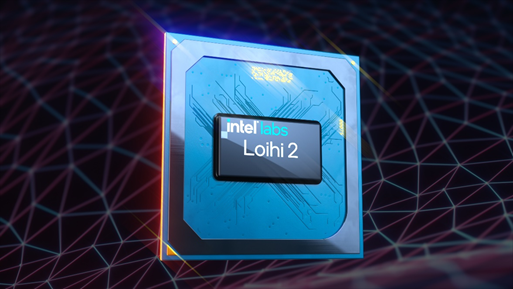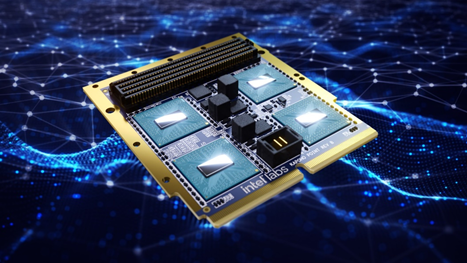Intel Labs launched the Kapoho Point development board, updated the Lava framework, and announced new Intel neuromorphic research community support projects.
Intel Labs is leading the development of neuromorphic computing through the Loihi 2 second-generation research chip and open source Lava software framework released last year. As part of Intel's goal of commercializing neuromorphic technology, Intel Labs is providing developers with new tools to advance the development process to the next stage. For example, the 8-chip Loihi 2 development board Kapoho Point can meet the needs of large-scale workloads through stacking and can achieve direct interconnection with low-latency event cameras (event-based vision sensors).

Loihi 2 is Intel's second-generation neuromorphic research chip. It supports new brain-like algorithms and applications, provides faster processing speed and higher resource density, while improving energy efficiency. (Image source: Intel Corporation)
In addition, Intel Research has updated the open source Lava framework to support programmable neurons, integer spike neurons, convolutional networks, and continuous learning. Starting with the latest version of Lava (v0.5), these new features enable Kapoho Point to run deep learning applications 12 times faster and with 15 times less energy than the same workload on the Loihi 1 system1. In addition, Intel has launched eight Intel-sponsored university projects through the Intel Neuromorphic Research Community (INRC).
Delivering the next generation of neuromorphic systems to community members
Kapoho Point, a Loihi 2-based development board, is a compact system that is ideal for a variety of small-sized devices and applications, from drones to satellites and smart cars. Kapoho Point can run AI models with up to 1 billion parameters and solve optimization problems covering up to 8 million variables. Compared with advanced solvers running on CPUs, it increases the speed by more than 10 times and reduces energy consumption by 1,000 times. In addition, Kapoho Point can be expanded by stacking multiple development boards to solve larger-scale problems.

The Loihi 2-based development board Kapoho Point is a compact system ideal for a variety of small-form-factor devices and applications, from drones to satellites and smart cars. (Image source: Intel Corporation)
The U.S. Air Force Research Laboratory (AFRL) is the first member of the research community to enable Kapoho Point and is using it for internal research involving learning based on spiking neural networks and problems that require real-time optimization. "As AFRL missions are conducted in the air and space, the space, weight and power budget of mobile platforms are very limited," said Dr. Qing Wu, senior scientist for data processing and development. "Neuromorphic computing technology provides an excellent computing solution for the needs of running AI algorithms in this environment."
Lowering the threshold for neuromorphic development through the Lava software framework
Updates to the open-source, modular and extensible Lava software framework include a range of improvements to the Loihi 2 feature set, such as programmable neurons, graded events and continuous learning.

Intel Labs has updated the open source Lava framework to support programmable neurons, integer spiking neurons, convolutional networks, and continuous learning. (Image source: Intel Corporation)
The Lava software framework can be downloaded for free on GitHub.
Neuromorphic Ecosystem Project
The Intel Neuromorphic Research Community (INRC) has launched eight Intel-supported university projects, including George Mason University, Queensland University of Technology, Graz University of Technology, University of Zurich, Brown University, Pennsylvania State University, University of Waterloo and University of Göttingen.
Research projects include adaptive robot positioning, wireless biomimetic sensor pulse decoding for brain-computer interfaces, neuromorphic Bayesian optimization, auditory feature detection, and novel brain-like architectures and algorithms.
Since its founding in 2018, the Intel Neuromorphic Research Community has grown to more than 180 members, including university labs, government agencies, and leading global companies such as Accenture, Lenovo, Logitech, and Mercedes-Benz.
Going forward, Intel Labs will continue to provide developers with new tools to make it easier for them to develop applications that solve real-world problems and continue to support community research.
1SDNN results for Loihi 2 are based on the Lava v0.5 benchmark conducted in September 2022, when executing a 9-layer PilotNet DNN inference workload as a Sigma-Delta neural network on Loihi 2, compared to the same network executed on Loihi 1 using SNN frequency encoding. Equivalent DNN operation counts from a traditional DNN execution with the same topology and the same number of 8-bit parameters. See Bojarski, Mariusz, et al., End-to-End Learning for Self-Driving Cars. arXiv preprint arXiv:1604.07316 (2016).
Previous article:Picotech PC802 5G small base station SoC and Shiju Networks 5G protocol stack are connected
Next article:Qualcomm and Quectel demonstrate Wi-Fi and 5G cellular link aggregation at MWC Las Vegas
Recommended ReadingLatest update time:2024-11-15 02:33





- Popular Resources
- Popular amplifiers
- Keysight Technologies FieldFox handheld analyzer with VDI spread spectrum module to achieve millimeter wave analysis function
- Qualcomm launches its first RISC-V architecture programmable connectivity module QCC74xM, supporting Wi-Fi 6 and other protocols
- Microchip Launches Broadest Portfolio of IGBT 7 Power Devices Designed for Sustainable Development, E-Mobility and Data Center Applications
- Infineon Technologies Launches New High-Performance Microcontroller AURIX™ TC4Dx
- Rambus Announces Industry’s First HBM4 Controller IP to Accelerate Next-Generation AI Workloads
- NXP FRDM platform promotes wireless connectivity
- WPG Group launches Wi-Fi 7 home gateway solution based on Qualcomm products
- Exclusive interview with Silicon Labs: In-depth discussion on the future development trend of Bluetooth 6.0
- Works With Online Developer Conference is about to start, experience the essence of global activities online
- LED chemical incompatibility test to see which chemicals LEDs can be used with
- Application of ARM9 hardware coprocessor on WinCE embedded motherboard
- What are the key points for selecting rotor flowmeter?
- LM317 high power charger circuit
- A brief analysis of Embest's application and development of embedded medical devices
- Single-phase RC protection circuit
- stm32 PVD programmable voltage monitor
- Introduction and measurement of edge trigger and level trigger of 51 single chip microcomputer
- Improved design of Linux system software shell protection technology
- What to do if the ABB robot protection device stops
- CGD and Qorvo to jointly revolutionize motor control solutions
- CGD and Qorvo to jointly revolutionize motor control solutions
- Keysight Technologies FieldFox handheld analyzer with VDI spread spectrum module to achieve millimeter wave analysis function
- Infineon's PASCO2V15 XENSIV PAS CO2 5V Sensor Now Available at Mouser for Accurate CO2 Level Measurement
- Advanced gameplay, Harting takes your PCB board connection to a new level!
- Advanced gameplay, Harting takes your PCB board connection to a new level!
- A new chapter in Great Wall Motors R&D: solid-state battery technology leads the future
- Naxin Micro provides full-scenario GaN driver IC solutions
- Interpreting Huawei’s new solid-state battery patent, will it challenge CATL in 2030?
- Are pure electric/plug-in hybrid vehicles going crazy? A Chinese company has launched the world's first -40℃ dischargeable hybrid battery that is not afraid of cold
- Quick, help me calculate the baud rate error problem, click here to see the picture and formula
- Jlink prompts error message when burning external flash
- How new antenna matching technology makes HF-RFID work
- Generate .bin .hex .txt files on CCS and burn them to MSP430 to make the LCD light up
- Digital video image elimination based on FPGADSP...
- Award-winning live broadcast: Registration is open for TI desktop DLP 3D printing, 3D scanning and industrial display applications based on DLP Pico technology~
- Is there any pure hardware?
- "Pingtou Ge Jianchi CDK Quick Start Guide"
- [AT32F421 review] + Display driver for digital tube module
- The difference between C language character array and ordinary array

 A review of deep learning applications in traffic safety analysis
A review of deep learning applications in traffic safety analysis
















 京公网安备 11010802033920号
京公网安备 11010802033920号